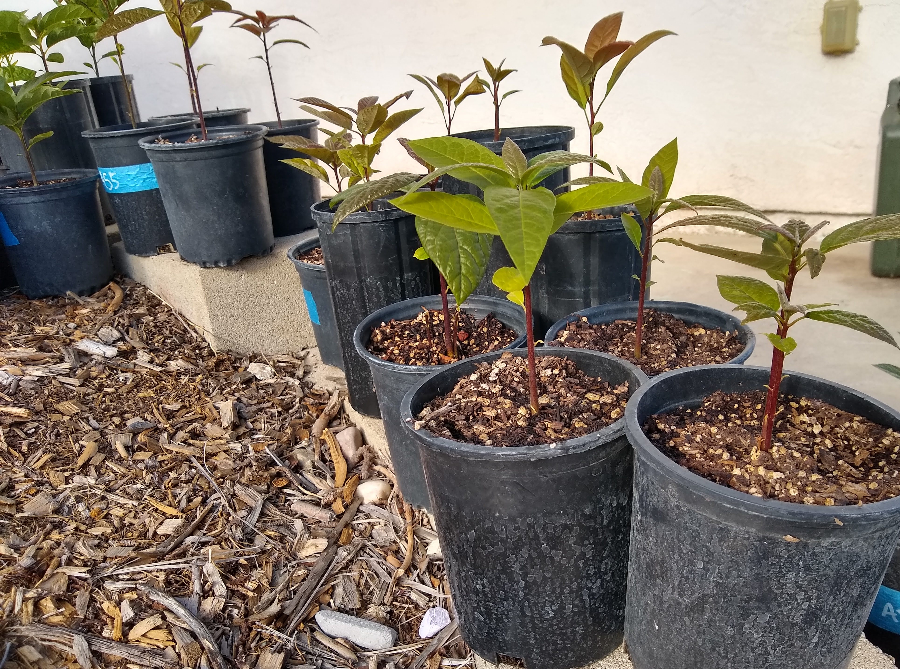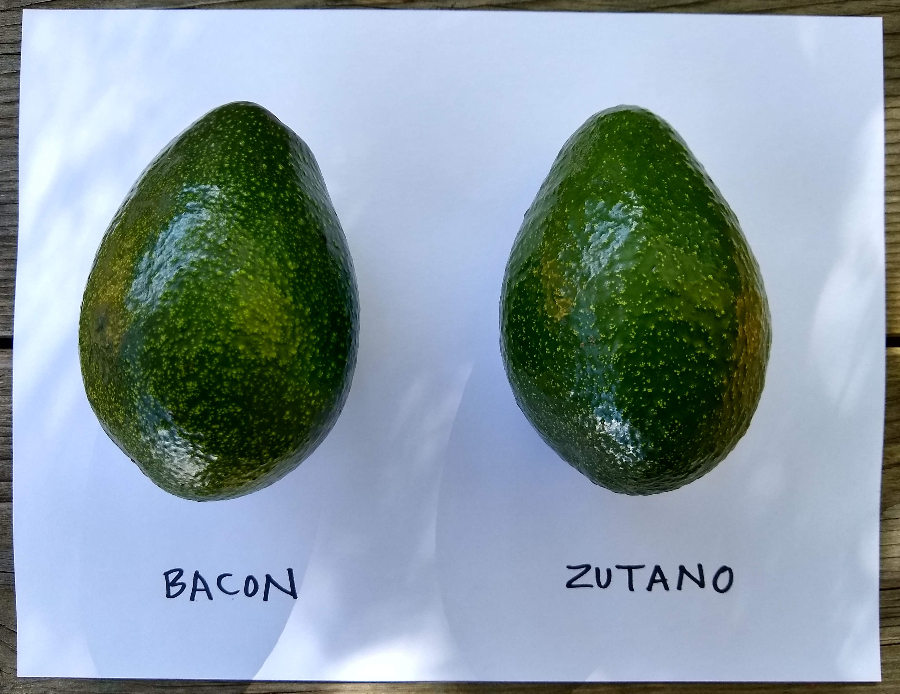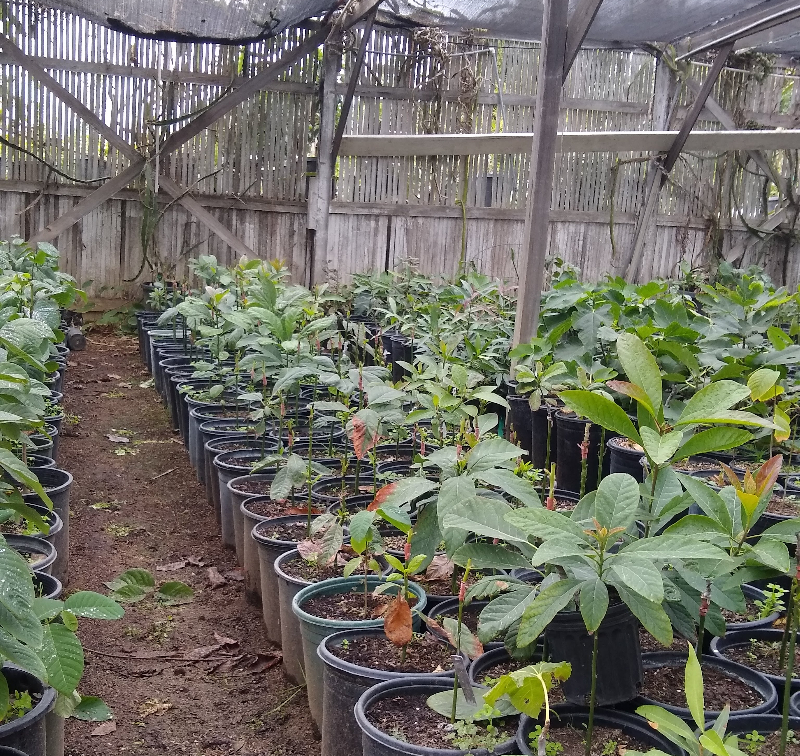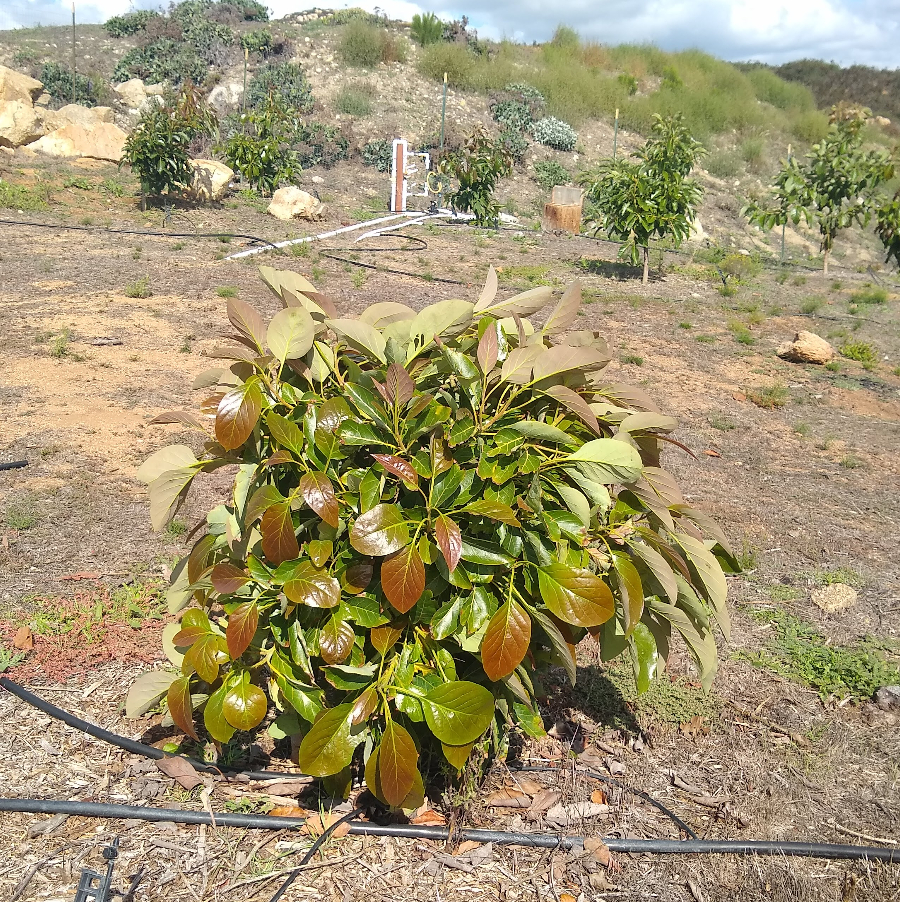You and I, we go to the nursery and buy our avocado trees. Not Brad. He is so well-rounded in avocado growing skills and knowledge that he has developed a new grove of hundreds of avocado trees from scratch.
Starting from seed
Brad planted over 200 avocado seeds, mostly from Zutano fruits, some harvested from his own Zutano tree.

After a few months, he planted these seedlings in the ground. This was ground on his acreage in the hills near Poway in San Diego County. He had also already installed fencing to keep deer out and he had laid out irrigation for the trees. He did most of this work by himself.
The avocado seedlings grew for a year or two in place until they were big and established enough to be ready for grafting.
Watch my three-minute video about Brad developing his new avocado grove and demonstrating his grafting technique:
Grafting to known varieties
Over the course of the last decade, Brad has tested out dozens of avocado varieties in his “old” grove. Fuerte, GEM, Gwen, Jan Boyce, Stewart, Mexicola Grande, Mexicola, Ardith, Nabal, Nimlioh, Holiday, Lamb, Murashige, Greengold, Carmen, Kahaluu, Hellen, Sir-Prize, Pinkerton, Bacon, and many more, they all got a chance to show their growth habits and fruit yield and quality.

Through this Brad discovered which varieties he and his family most liked to eat, and he discovered which varieties were suitable to his climate and capable of high production, along with having good tree architecture. In the end, Brad’s top three were Reed, Hass, and Sharwil. These he chose for his new grove, designed as a farm and not just for the family.
As he already had a few trees of those varieties in his old grove, he was able to cut branches off them in order to use for grafting trees in his new grove. He had his own germplasm, so to speak.
Why not buy trees?
Let’s back up and ask why Brad didn’t buy trees of these varieties already grafted and grown up by a nursery. Wouldn’t that have been faster? Yes, but he chose the DIY route because it was cheaper and he wasn’t in a hurry.
Why Zutano seedling rootstock?
And why did Brad choose to grow Zutano seeds for his rootstock? Why not seeds of another variety, or why not clonal rootstocks? He chose Zutano because he had already seen in his old grove that trees on Zutano seedling rootstock grew and produced satisfactorily in his conditions. He has tried some clonal rootstocks and he has tried seedling rootstocks of other varieties — Bacon, for example — but came back to Zutano for the performance (and compared to clonal rootstocks, also because of the price).

Grafting timing and method
Brad did his grafting in early December. This time of year worked well in his location because the sap was still moving in the trees and the bark was slipping so he could peel it in order to use his desired grafting method, called a veneer or bark graft (as seen in the video). Once grafted, the trees had all winter to heal graft unions under a weak sun before beginning to grow and shade themselves by late spring, when it gets very hot in his location.

Two stages and a few failures
All doesn’t go according to plan. It never does. A few of Brad’s grafts failed, and he had to regraft them the following year.
Brad also didn’t plant out the entire area at one time. He did it mainly in two stages, with two main batches of seedling rootstocks and two Decembers of grafting, the most recent being December 2023.
And a portion of his newest rootstocks are still not ready for grafting today. In December of 2024, they should be.
Ready for avocado production
But Brad’s earliest batch of trees, grafted in December 2022, are now ready to set and hold their first crop here in spring 2024. Many of the trees flowered and set some fruit last year, in fact, but Brad removed them as he judged that the trees were not big enough to carry a proper crop at that point.
So this spring is an exciting time. The payoff period is in view. Years of thinking, planning, sweating, digging, taping, staking are about to turn into actual avocados.
Tradeoffs with this method
You might ask why Brad didn’t graft the trees while small and in pots, as is done at nurseries.

One part of the answer is that the grafts grow faster on larger rootstocks. So rather than caring for hundreds of grafted trees in pots for a year or two as they grew slowly, which requires a lot of space and more careful watering (since potted plants are more susceptible to drying out), Brad chose to let the seedlings gain size in the ground so that when he grafted, the tops would grow more rapidly.
The grafts that Brad did each December grew back in one year to approximately the size they had been when the rootstock was cut for grafting.

One other advantage of Brad’s method is that the trees are tougher at a younger age compared to container-grown nursery trees. His location is both hot and windy. By growing the trees in the field for more of their lives, they end up needing less staking and being able to handle heat better at a young age.
My take away
I have been lucky enough to watch Brad develop this new grove from the time it was only a thought. What I take away from watching Brad’s work is a sense of pride for him. He has accomplished a grand endeavor.
Secondly, I take away a reminder that we have access to all we need in order to grow avocado trees or any other fruit tree. We are not at the mercy of nurseries that might seem to employ mystical propagation techniques or experts that might seem to possess recondite horticultural knowledge.
Brad is an electrical engineer who became interested in avocado trees and spent time and effort learning about them and connecting with others who liked them and could share information and varieties. Given time and effort, every one of us can do the same, on any scale.
Some related posts of mine that you might like to check out:
And you might also like:
Gray Martin’s video series on grafting avocados
Check out a list of all of my Yard Posts here.
Notice there are no ads on The Yard Posts? That’s because of the contributions of hundreds of cool Yard Posts Supporters. Thank you, Supporters! You can become one today.




An electrical engineer who knows how to connect the cambium layer of a scion and a root stock? Will wonders never cease! Love the use of a simple leaf to encapsulate and shade the young scion.
A great legacy to avocado farmers of San Diego. Successful grafting is an art!
Well done.
I’m going to do that! But, I am going to leave some of the original seedling root stock to mature and eventually set fruit because I want to explore the genetic diversity in hopes of finding something worth keeping. I am a hobbyist rather than a commercial grower, so my priorities are a bit different. I am currently clearing land to put my first seedlings into the ground. Whatever is cold hardy enough to naturalize in my marginal climate will eventually become the root stock for my grove. I also will be spacing much closer in my project because I expect some of the seedlings to die off in the winter. I also want leaves from the trees to create a deep mulch to suppress weeds because where I live in Japan the rainy season in the summer creates jungles seemingly overnight, and so just keeping land cleared requires a lot of labor – especially on a slope too steep to use heavy machinery.
That sounds great. Because you leave some of the rootstock, you won’t get growth from the scion as rapid as if you removed all of the rootstock, but I love the idea of discovering what comes from your seedling rootstocks.
A couple years ago I cut off the top of an avocado seedling to graft it, but I wanted to discover what that seedling could become too so I pulled a scion from it and grafted it to another larger tree. (It is growing strongly but has yet to flower.)
I have been wondering about how to explore what fruit my rootstock might give also. Would it be productive to leave a low horizontal branch on the rootstock and graft scion to the leader? Then if the rootstock fruit is good, I could promote it with pruning or topworking and put the scion wood onto a lesser rootstock.
Hi Warren,
I can see three main options:
1. Let the seedling fruit before you graft onto it and use it as a rootstock.
2. Graft onto the seedling’s leader but allow a sublateral branch of the rootstock to remain, and keep it pruned so it doesn’t take over your graft. (Your idea)
3. Graft onto the seedling but use a branch cut from the seedling as a scion to graft onto a separate rootstock/tree.
I’ve tried all three of these. They can all work. They all have advantages and disadvantages. Which you choose might depend on how much space you have, how much time you want to allow, your grafting skills, etc.
You’d be surprised how many electrical engineers turn to farming, especially in their later years 🙂
Now that you say that, Mike, I do know another electrical engineer that also became a farmer. This begs for exploration.
Greg: Simply fantastic resources embedded in “How Brad Grew his Avocados” was the “Gray Martin video series” I watch 6 of them, totally blown away. His knowledge , cutting 2’- 4” diameter wood to splice and bark graft. Just amazing. Many questions as I learn. hard to understand why he would cut the growing scion back as he only wanted “one’ bud popping??? If a grafted scion was growing and 3-4 buds were popping, wouldn’t you want to keep them all? Or is that Grays method of “forcing” maximum growth? A grafting clinic would be fabulous! Thank you.
Hi Joe,
Yes, that is Gray’s method of forcing maximum growth, and getting a desired shape out of the tree. A few weeks ago, I visited Gray and looked at his trees and talked to him about this. I am convinced that he is right about it.
If you want maximum growth from a particular scion AND you want a balanced, upright shape to that scion’s growth as it becomes a tree, then you choose a single, strong bud and remove all others. Then that bud grows rapidly and later forms side branches in a balanced way such that you end up with something that looks like a Christmas tree in a year or two. I saw multiple examples of this at Gray’s place. I also did this to one of my trees that I grafted about two years ago, with Gray’s guidance, and it works.
It’s extremely important to know what will grow in your very own micro-climate. In my area I found the Reeds were excellent because of their later time to blossom; which is late Spring. So the bees are out to pollinate. I have also found out seedlings grow larger, faster and stronger. I have a Zutano, Gem, Bacon and looks like a Fuerte seedling producing a very interesting new fruit. Now still hanging on the tree. I have grafted a few and yes they take a long time to grow. Experimenting in your yard takes time but finding a great fruit is worth it. I also love the Mexicola Grande the flavor is very different than other avocados. My favorite is the Fuerte though. That is just the best I think. Growing my trees in worm rich compost works with my clay soil. Takes time to grow but worth it.
Very 😎 cool ! I’m in a different area Perú. We are experimenting with different rootstocks to see what will adapt best to our local climate i.e. cool wet humid 6000ft with lots of wet soils ! We are trying Zutano which grows extremely fast but very susceptible to root rot or as they call it (muerte descendente). I have been trying to figure out which types of plants i.e. criollo or native adapted ones for use as rootstocks. I am now trying hass for rootstock since I’ve seen there use in videos in Columbia and they say the roots are beter adapted to cooler wet climates. I noticed a few differences on the grafting we generally graft up at least 3ft and from there we leave at least three to four branches for the bowel or cup. I would really like to hear from some experts on this subject since my local experts seem to lack expertise .
Hi Mr. Balcom,
I have also heard of the use of Hass seedlings as rootstock in Colombia. That growing environment is a whole different world from here.
I think that your grafting style will depend partly on your tree spacing, which depends partly on the ultimate tree size you want. If the trees are to be kept short, say 12 feet or less, then you would want more of a central leader type of scaffold branch structure and you might just choose a single graft and bud to grow up and become that leader. But if you want larger trees at wider spacings, then you can make multiple grafts and allow more scaffold branches, in more of a bowl or cup shape.
Hi Greg – Thank you for this fun and inspirational story! I ended up watching all of the Gray Martin videos and like Joseph’s comment above, was amazed at a lot of the advice and salient points. Thank you for reposting those links here! I am now even more excited to go graft my avocados in Feb.
I had two Qs for you:
1. Do you or any of your farmer colleagues/friends find that grafting “like on like” works well or better? So if I grow some seedlings from fuerte seeds. And when it’s time to graft, if I graft a fuerte scion from a mature tree, is there any evidence that this will work “better” than other rootstocks? Or is the choice of rootstock really a local thing and we should find the best rootstock for our location?
2. Do you use tar on your grafts? I haven’t been using tar on mine – but I’ve done like 4 so far and of those, 3 have taken so I’m happy with the take rate but wondering if I just got lucky and need to tar the grafts and cut rootstock. Especially if I use Gray Martin’s technique of removing all except one bud if I’m lucky enough to have multiple grow on a graft.
Thank you for all the advice! This was a really fun and inspiring article!
And we really enjoyed the batch of Fuerte we purchased drom your link a few days ago. Each avocado was perfect!
Best,
MB
Hi MB,
I am also excited for this grafting season! I look forward to trying some new techniques; there’s always something new to test out.
The “like on like” question is a great one. I don’t know of anyone who has tested it on a grand scale although I should search for such experiments in some of the oldest literature. I do have a little personal experience with it.
I have grown two of these kinds of trees. I have a Gwen on Gwen seedling and a GEM on GEM seedling. (The GEM on GEM seedling I gave to a friend and it is now growing in his yard.) Both of these trees are growing very well. The Gwen x Gwen in my yard is more productive than any other tree of similar age.
I definitely wouldn’t extrapolate that this is the way to go in all settings, but I can say that it is something I intend to try more of.
I don’t use tar on my grafts. If I cut a large stock to make a bark graft I just cover the top with tape, similar to how Brad did in the video.
Glad you enjoyed the Fuertes!
Great! Thank you! I’ll try to experiment with this “like on like” idea if I can and will report back 🙂 … probably in a few years 🙂
Ok good to know about the tar. Taping it up seems simpler (for me at least). Maybe tar is better if you have very large surface areas to cover like you might in a large orchard that was being refgrafted or something.